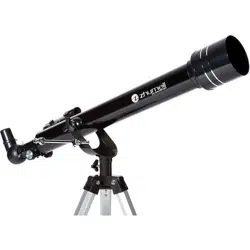Loading ...
Loading ...
Loading ...

5
Never look at the sun without using a solar lter. Do not use an
eyepiece solar lter. When using a solar lter, do not remove the
full lenscap, view only through the small opening. Looking at the
sun without proper use of a solar lter can cause permanent eye
damage, included blindness.
Using your nderscope will help you locate celestial bodies much
more quickly as the nderscope is equipped with a wider eld of
view than your telescope. To simplify focusing while viewing, start
with the lowest power magnication and work up to the desired power.
When viewing faint deep-sky objects, images will not show color.
The human eye is not able to distinguish the dierences in color
found in such dim images. The lack of color is due to human anatomy,
not any limitations of telescope construction.
VIEWING THROUGH YOUR
ZHUMELL TELESCOPE
CHECKING AND ALIGNING YOUR FINDERSCOPE
1.
Insert the lowest-power (25mm) eyepiece into the diagonal prism.
Focus the eyepiece to view an easily recognizable, stationary
distant object like a sign or lightpole.
2. Turn on the nderscope by turning the knob on the side of the
unit, but be careful not to move the telescope in any way. Hold
your eye about a foot behind the glass lens of the nderscope
and look through it to nd the red dot. Check to see if the object
viewed through the telescope eyepiece is lined up with the red
dot. If not, your nderscope must be re-aligned.
3. To align your nderscope, use the up & down and left & right
adjustment knobs on the bottom and side of the nder to move
the red dot until it lies over the object you see in your eyepiece.
It may take many tries to get it exactly right, but it will make
nding objects much, much easier when you’re ready to use
your telescope.
Finderscope alignment is the rst step to ne-tuning your telescope
and viewing celestial objects. Follow these steps to properly set up
and align your nderscope.
ADJUSTMENTS
Your telescope can be maneuvered along two axes, altitude and azimuth.
The longitudinal axis (left to right) is commonly referred to in astronomy
as “azimuth”. To adjust the azimuth of your telescope, loosen the
thumbscrew where the telescope attaches to the tripod. Gently
swing your telescope left or right until it faces the object you seek.
Tighten the thumbscrew to hold the telescope in place.
The latitudinal axis (up and down) is commonly referred to in astronomy
as altitude. To adjust the altitude of your telescope, loosen the knob
holding the slow motion control and raise and lower the angle of
the scope until it is pointed near the object you seek. Secure it in
place by tightening the knob holding the slow motion rod. For ne
adjustments, simply turn the handle in the middle of the slow motion
rod to slowly raise and lower the scope.
For best results, only adjust one axis of your telescope position at a time.
As you set out to begin viewing, one of the easiest and most
enjoyable objects to check out is the moon. Finding the moon
and adjusting to view it is a good way to acquaint yourself with
the movements of your telescope.
Practice using the azimuth and altitude adjustments to bring the
moon into the center of your view. Focus your view by turning
the knobs located on the smaller end of the OTA. Once you’ve
located the moon and successfully focused your telescope on it,
experiment with focusing and your dierent eyepieces. This will
help familiarize you with the dierent results you can get from
your telescope.
THE MOON
COOL VIEWS WITH YOUR
ZHUMELL TELESCOPE
THE PLANETS
Once you’ve used your telescope to view the moon, you should
be familiar with the basic telescope movements and adjustments
you need. Next stop: the planets. Not all the planets are visible
from one area at one time, so you’ll need to do a little research
before you begin. There are a number of online resources helpful
for discovering what planets and objects should be visible in your
area on any given night.
To nd a planet, you must rst locate it with the naked eye. Once
you’ve got its general location, point your telescope in that direction
and center the planet in the crosshairs of your nderscope. Once
the planet is lined up in the nderscope, begin to view the planet
through your telescope using the lowest power (longest focal
length) eyepiece. You may need to make slight adjustments to
the telescope aim and you will need to focus the eyepiece to
bring the planet into full view.
For a closer look at the planet, replace the low-powered eyepiece
with a higher-powered one and refocus your telescope.
Loading ...
Loading ...
Loading ...
